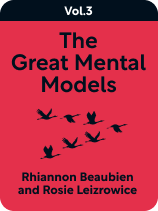

This article is an excerpt from the Shortform book guide to "The Great Mental Models Volume 3" by Rhiannon Beaubien and Rosie Leizrowice. Shortform has the world's best summaries and analyses of books you should be reading.
Like this article? Sign up for a free trial here .
Would you like to know how to understand human behavior better? Do you want to change your own behavior?
A lot of the ideas in The Great Mental Models Volume 3 are concerned with understanding behavior. In fact, when the authors talk about systems, they are most interested in how systems explain behavior. In particular, they discuss what feedback loops and algorithms tell us.
Let’s look at how systems shape our behaviors and explore some factors to keep in mind if the goal is behavior change.
Understanding Human Behavior
In the book, authors Rhiannon Beaubien and Rosie Leizrowice never define what they mean by “systems.” They seem to use the term as it’s used in systems science. In this context, a system is a group of individual components that interact with each other in defined ways. A system can be anything from a computer to an ecosystem to a government. Thinking about systems means thinking about interactions, interdependencies, contexts, and so on. Beaubien and Leizrowice are mostly interested in human systems, including individual behaviors, group interactions, and the functioning of organizations like businesses and governments.
If you want to know how to understand human behavior, the authors say, look at feedback loops and algorithms.
Feedback Loops
According to Beaubien and Leizrowice, many human behaviors are based on feedback loops—effects that occur whenever a system’s output affects the system’s future behaviors. The authors point out that there are two types of feedback loops: balancing and reinforcing.
- A balancing loop occurs when the output causes a change in behavior. If you’re working at your computer and find that your back is sore and you’re losing focus on your work, you might respond by taking a break and going for a walk. Here your body has given you a balancing feedback loop. As you work, discomfort builds, focus wanes, and your work capacity diminishes. Eventually, this feedback prompts behavioral change.
- A reinforcing loop occurs when the output encourages repeat behavior. In the previous example, when you go on your walk, you find yourself feeling refreshed and happy. These positive effects make you more likely to go for another walk tomorrow. That’s a reinforcing feedback loop, since the results of the behavior encourage more of the same behavior.
(Shortform note: Not all behavioral feedback loops necessarily fit either of these two categories. Some feedback loops offer neither reinforcements nor consequences, but instead influence your behavior simply by making you more aware of it. For example, road signs that show the speed limit and a radar reading of a driver’s current speed are surprisingly effective at getting drivers to slow down even if police never enforce speed violations near these signs.)
The authors argue that, in addition to shaping individual behaviors, balancing and reinforcing feedback loops interact to create many of our social institutions, which in turn form a feedback loop with society at large. They give the example of the justice system, in which criminal judgments and penalties provide clear feedback on certain types of behaviors. This feedback can be reinforcing or balancing:
- Unwanted behavior (say, theft) forms its own reinforcing feedback loop if left unchecked by the law. If someone steals and gets away with it, that person will be encouraged to steal more. If that person steals everything from you, you’d be encouraged to steal from others to replace your losses. Without clear legal protections or consequences, theft would likely run rampant.
- However, the legal system provides a balancing feedback loop to correct the unwanted behavior. If someone steals from you and goes to jail, that person will be less likely to steal in the future. Plus, you’ll have incentive not to steal, both because you saw someone get punished for stealing and because you got your possessions back when the thief got caught.
(Shortform note: Social feedback loops aren’t always so straightforward. Sometimes laws and policies create unintended consequences, such as environmental protection laws that accidentally encourage developers to destroy habitats before they have a chance to be legally protected. In cases like this, a law that was meant to provide balancing feedback ends up reinforcing the behavior it was meant to curb.)
Behavior Change
If you understand feedback loops, you’ll have a better chance of changing your behaviors if that’s your goal. For one thing, feedback loops help explain why behavior change is so hard. The authors point out that feedback can be short term or long term and that sometimes we don’t behave in our best interests because, by the time we get long-term feedback, we can’t see what caused it.
To return to a previous example, imagine that when you start losing focus on your work, instead of taking a break, you have a cup of coffee. The coffee tastes good and it makes you feel more alert. The short-term feedback reinforces your choice to drink the coffee. That night, you have trouble falling asleep. It’s been hours since you drank the coffee, so you don’t notice the long-term feedback that’s telling you how caffeine affects your sleep. Until you see the connection between a behavior and its long-term feedback, you can’t act on the feedback.
(Shortform note: For that reason, in Nudge, Richard H. Thaler and Cass R. Sunstein argue that some decisions should be manipulated by policymakers to help us make better choices. Those manipulations—which they call “nudges”—involve changing how a choice is presented so that people are more likely to choose the better (healthier, safer, more beneficial, and so on) option without realizing they’ve been influenced. To put it another way, Thaler and Sunstein recommend creating a new short-term feedback loop to compensate for the feedback delay that occurs in some situations.)
Because of the potential gap between behavior and feedback, the authors say that, if you want to change a behavior, you should anticipate future consequences by analyzing any feedback loops that might be in play.
| How to Change Behaviors Using Feedback Loops In Atomic Habits, James Clear outlines a theory of habit formation that can help put our knowledge of feedback loops into practice. Clear says that habits consist of four stages: The cue—an environmental stimulus that triggers the behavior in the first place. The craving—your emotional reaction to the cue. The response—the behavior you perform to satisfy your craving. The reward—the satisfaction or relief your behavior delivers. Note that each of these stages is a feedback loop: The cue triggers emotional feedback. The emotional feedback triggers a behavior. The behavior triggers a consequence. If the consequence is reinforcing, a habit forms. The trick is that a fully formed habit becomes one big feedback loop, which makes it hard to see each of these individual loops at work. But you need to see them if you hope to change a habit or cultivate a new one. Luckily, Clear offers step-by-step recommendations for manipulating each of these feedback loops to your advantage. For example, if you’re trying to adopt a new positive behavior, Clear says you should: Consciously choose a cue for the behavior. In other words, pick a stimulus that will trigger the new feedback loop. Make sure the cue triggers positive emotional feedback—this makes you more likely to do (rather than avoid) the new behavior. Make it easier to do the desired behavior—this increases the chances that the cue elicits the behavioral feedback you wanted instead of stressing you out because the new behavior feels too hard. Make the new behavior rewarding. In other words, provide yourself with reinforcing feedback so that you’re more likely to repeat this whole process the next time the cue comes up. If you construct each of these smaller feedback loops correctly, then over time, the loops merge together into one big feedback loop—your new habit. |
Algorithms
Not all behaviors are driven by feedback loops. The authors point out that some behaviors in a system can be described as algorithms. An algorithm is a set of simple steps (like a recipe) that turns input into output in a consistent, predictable way each time. Algorithms are valuable because they’re consistent and repeatable, and they replace the need to make decisions about the same things over and over.
The most obvious examples of algorithms are computer algorithms, but many biological and social processes also follow algorithmic rules. For example, basic rules of courtesy suggest that when making a request, you preface the request with a word like “please” and that you follow up a fulfilled request with a phrase like “thank you.” You were probably taught this algorithm when you were young. As a result, you don’t need to think about how to make a request every time you make one. And because everyone knows the basic request algorithm, other people will understand your intentions when you use that algorithm
| How to Change Behaviors Using Algorithms Like feedback loops, algorithms provide a powerful tool for understanding and changing behaviors. In Algorithms to Live By, Brian Christian and Thomas L. Griffiths provide a number of algorithms that they say can improve your life by saving time and simplifying choices. Their algorithms cover everything from decisions (they suggest evaluating 37% of your options, then making a choice) to home organization (they suggest placing piles of your most used items in easy reach). Of course, while algorithms can be helpful, they aren’t perfect—no rules are ideal for every situation. For example, mathematician Hannah Fry demonstrates that Christian and Griffith’s 37% rule leads to a low chance of choosing the best option—instead, she suggests adjusting your decision criteria to improve your chances. Still, the concept of algorithms is helpful because it suggests the possibility of streamlining the behaviors and choices you encounter every day. |
Like feedback loops, algorithms explain more than just individual behavior—Beaubien and Leizrowice point out that social structures like laws and constitutions also function as algorithms by providing clear if-then relationships between behaviors and consequences. In the criminal justice system, for example, there are a set of rules specifying what punishments might be applied if you steal. These rules take into account what you stole and how—By force? With a weapon?—in order to generate a penalty. These social algorithms work together to produce the social feedback loops we discussed earlier. Because the criminal justice system is based on a set of publicly known algorithms, everyone knows what to expect if they commit a crime.
Algorithms are particularly useful in large and complex systems. Automating and standardizing a procedure makes it easier to repeat consistently and removes unhelpful decision-making and variations. In the criminal justice system, the flow of events from arrest to arraignment to trial to sentencing to appeal are codified into a standard practice. Judges, attorneys, and defendants don’t need to invent or negotiate trial procedures every time a crime is committed, and (at least in theory) this standardization makes the system fair and consistent.
(Shortform note: According to Daniel Kahneman, Olivier Sibony, and Cass R. Sunstein, algorithms reduce noise—unwanted variance in human judgments. The authors specifically talk about computer algorithms, but we can extend their argument to see that the kinds of social algorithms we’re discussing here also reduce noise by limiting the number of decisions people have to make in complex situations such as criminal proceedings. Whenever you work in a group, it’s worth thinking about the algorithms that drive the group’s behaviors and seeing whether new algorithms could improve the group’s efficiency and consistency.)
Exercise: Change Your Behavior
Many of the mental models in this book are concerned with behavior—how it works and how to change it. Let’s look at how you might put these models to work to modify your own behaviors.
- Think of a behavior you want to change or a new habit you’d like to adopt. What feedback loops and/or algorithms drive your current behavior?
- What feedback loops and/or algorithms could you put in place to lead to your desired behavior?
- How do you hope your new behavior will compound to create bigger gains in the future?

———End of Preview———
Like what you just read? Read the rest of the world's best book summary and analysis of Rhiannon Beaubien and Rosie Leizrowice's "The Great Mental Models Volume 3" at Shortform .
Here's what you'll find in our full The Great Mental Models Volume 3 summary :
- How to understand anything in the world by learning a finite set of rules and patterns
- A look at how humans are driven by algorithms
- Why you shouldn't be fooled by randomness






